
Beverly Atlee Cleary was an American writer of children's and young adult fiction. One of America's most successful authors, 91 million copies of her books have been sold worldwide since her first book was published in 1950. Some of her best known characters are Ramona Quimby and Beezus Quimby, Henry Huggins and his dog Ribsy, and Ralph S. Mouse.

The Ramona books are a series of eight humorous children's novels by Beverly Cleary that center on Ramona Quimby, her family and friends. The first book, Beezus and Ramona, appeared in 1955. The final book, Ramona's World, was published in 1999. Two books in the series were named Newbery Honor books, Ramona and Her Father and Ramona Quimby, Age 8. Ramona and Her Mother received the National Book Award. Sometimes known as the Beezus and Ramona series, as of 2012, the books were being marketed by HarperCollins as "The Complete Ramona Collection".

Number the Stars is a work of historical fiction by the American author Lois Lowry about the escape of a Jewish family, the Rosens, from Copenhagen, Denmark, during World War II.

Henry Huggins is a character appearing in a series of children's literature novels by Beverly Cleary, illustrated by Louis Darling, and first appearing in Henry Huggins. He is a young boy living on Klickitat Street in Portland, Oregon. In the novels, he is in elementary school. The novels take place in the 1950s, which is when Cleary wrote most of the books. The books describe adventures that he experiences in his neighborhood and his interactions with other neighborhood children. He has a dog named Ribsy and a part-time job doing a paper route in North Portland.

Ramona the Pest, by Beverly Cleary, is the second book of the Ramona series and the first to focus on Ramona Quimby as the protagonist. This children's book chronicles the adventures of Ramona's first few months at kindergarten. The book's title is derived from the characterization of Ramona as a "pest" by many, including her older sister Beatrice, known as "Beezus." Ramona the Pest was first published in 1968 and featured illustrations by Louis Darling. Other illustrators have since updated Ramona the Pest, including Alan Tiegreen, Tracy Dockray, and Jacqueline Rogers.

Criss Cross is a novel by Lynne Rae Perkins that won the 2006 Newbery Medal for excellence in children's literature. It includes the character Debbie from her previous novel, All Alone in the Universe, but introduces several new characters, primarily her neighborhood friends Hector, Lenny and Phil.

Otis Spofford is a 1953 children's novel by Beverly Cleary.

Ramona and Her Mother by Beverly Cleary is the fifth book of the popular Ramona series. Mr. Quimby has found another job, though it is one he does not like very much. Ramona finds herself caught between being too young to stay home alone and too old to enjoy playing with pesky Willa Jean. She is trying to grow up, but sometimes it seems like her family is making it harder. Ramona and Her Mother won the 1981 National Book Award.
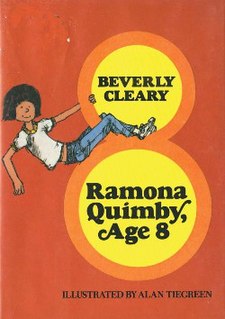
Ramona Quimby, Age 8 (1981) is a novel by Beverly Cleary in the Ramona series. Ramona Quimby is in the third grade, now at a new school, and making some new friends. With Beezus in Jr. High and Mr. Quimby going back to college, Ramona feels the pressure with everyone counting on her to manage at school by herself and get along with Willa Jean after school every day. Ramona Quimby, Age 8 was named a Newbery Honor book in 1982.
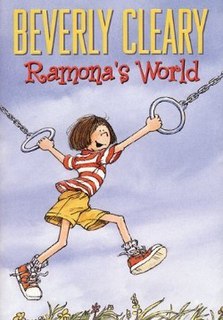
Ramona's World is the eighth book in the Ramona Quimby series by Beverly Cleary. Ramona and her sister Beezus are growing up. Ramona is in the fourth grade now, and for the first time she has a best girl-friend, Daisy Kidd. At home she tries her best to be a good role model for her baby sister Roberta, but finds baby sitting harder than she expected. Published in 1999, Ramona's World was written fifteen years after its predecessor, Ramona Forever. It was the last published installment in the series, as well as the last book Cleary published before her retirement and her death on March 25, 2021.

Beezus and Ramona is a 1955 children's novel written by Beverly Cleary. It is the first of Cleary's books to focus on Ramona Quimby and her sister Beatrice, known as Beezus. Beezus and Ramona is realistic fiction, written from nine-year-old Beezus's point of view, as she struggles to get along with her four-year-old sister. Eventually becoming the first book of the Ramona series, it was originally illustrated by Louis Darling; later editions were illustrated by Alan Tiegreen and then by Tracy Dockray.

The Moffats is a children's novel by the American author Eleanor Estes, the first in a series of four books about the Moffat family. The Moffats tells about four young children and their mother who live in a small town in Connecticut. Their adventures are based on Estes' memories of her childhood and focus on a working-class, single-parent American family during World War I.
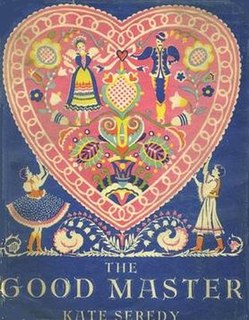
The Good Master (1935) is a children's novel written and illustrated by Kate Seredy. It was named a Newbery Honor book in 1936. The Good Master is set in the Hungarian countryside before World War I and tells the story of wild young Kate, who goes to live with her Uncle's family when her father can't control her and at the end she goes back to her father. At Uncle Marton's suggestion, Kate and her father move back to the country to live, to be near Marton and his wife and son. Like his brother Marton, Kate's father Sandor is a countryman and misses rural life. And he sees what a wonderful effect country life has had on Kate.
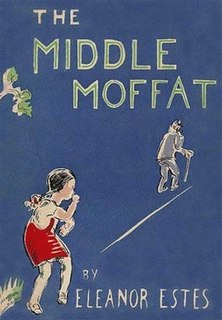
The Middle Moffat by Eleanor Estes is the second novel in the children's series known as The Moffats. Published in 1942, it was a Newbery Honor book. The title comes from Janey Moffat, who feels a little lost among her three siblings. Being neither the oldest or youngest, she decides to become the 'Middle Moffat' to help herself feel more important. The Moffats is set in small town Cranbury, Connecticut during World War I.
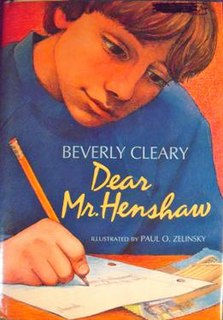
Dear Mr. Henshaw is a juvenile epistolary novel by Beverly Cleary and illustrator Paul O. Zelinsky that was awarded the Newbery Medal in 1984. Based on a 2007 online poll, the National Education Association listed the book as one of its "Teachers' Top 100 Books for Children".

Henry and Beezus is the second book in the Henry Huggins series. This humorous children's novel was written by Beverly Cleary and published in 1952. Henry comes up with many ways to earn money for the new red bicycle he wants, but they all seem to end up with him in trouble. Finally his friend Beezus gives him an idea that actually works.
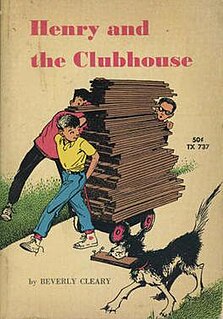
Henry and the Clubhouse, by Beverly Cleary, is the fifth book in Henry Huggins series. Now that he has the paper route he wanted so badly in the previous book, Henry and the Paper Route, Henry finds that it's harder than he expected. His earnings are going for the clubhouse he and his friends are building. One of the boys insists that it be a "Boys Only" club, and that causes trouble with Henry's friend Beezus Quimby and her little sister Ramona. Henry and the Clubhouse was published in 1962.

The Moffat Museum by Eleanor Estes is the fourth and final novel in the children's series known as The Moffats. Published in 1983, it appeared forty years after the preceding book. The title refers to a small museum that the four Moffat children set up to help them remember the special times in their lives now that they are growing up. Like the rest of the series, The Moffat Museum is set in small Cranbury, Connecticut in the early 1900s.

My Own Two Feet: A Memoir (1995) is Beverly Cleary's second memoir after A Girl from Yamhill (1988). It is a New York Times Notable Book.

Umbrella by Taro Yashima is a children's picture book that was named the 1959 Caldecott Honor Book. It was originally published in 1958 then later reprinted in August 1977 by Puffin Books.




















